The HP TouchPad Review: webOS on the Big Screen
by Anand Lal Shimpi on July 17, 2011 11:11 PM ESTwebOS Vernacular: Cards, Stacks and a Whole lot of Awesome
Two years ago I was still having webOS withdrawals. No one had even come close to duplicating the webOS multitasking experience and at least with iOS, you couldn't even multitask. I also missed Synergy and the unified messaging I got with my Pre. Every now and then I'd wish I was using webOS.
Since then I'd moved on. While the HP announcements earlier this year were interesting to me, they just didn't spark the same sort of excitement that I got from webOS in the early days. Perhaps it was just that I had gone too long without using a Palm device.
When I first picked up the TouchPad it started to come back to me. The webOS UI hasn't aged terribly well. It does feel a little bland compared to the effects you get in Android or iOS but the functionality is definitely still there.
There are three basic elements to webOS: the home screen, the launcher and the card. The home screen is unlike Android or iOS, there's just one single home screen. You also can't put icons on the aforementioned home screen, it's just there to act as a background.
Along the bottom of the screen are five quick launch icons. You can customize these but you can't add any more than five. Next to those icons is an up arrow, tap it and you'll bring up the launcher.
The launcher is the webOS equivalent of the iOS home screen or the Android all apps list. Like Honeycomb, the webOS launcher is divided into multiple tabs: apps, downloads, favorites and settings. You can move apps between any of these tabs, you don't have to actually obey their categories (e.g. you can put Pandora on the settings page, or move Print Manager to downloads). App icons can't exist in two tabs at the same time so once you move one it's no longer exists in its original location.
You can tap the category names to switch between tabs or simply swipe left/right to flip between them. Each category can hold more than a screen full of apps, you just scroll down to reveal more.
Settings in webOS take on more of a Mac/PC-like role. General system settings are accessed via the appropriate icon on the settings tab, but you also get per-app settings through each application's own app menu. I personally believe this is a more scalable setup to the iOS approach which puts all settings in one centralized location.
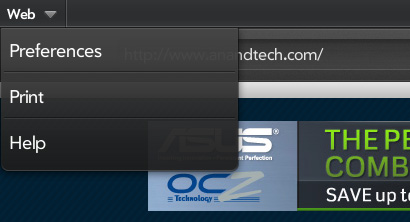
Having a really long page of settings just doesn't seem to be as good of an idea for scalability when you start adding a lot of apps, not to mention it slows you down when you want to change a setting within an app you're currently using.
So far everything seems pretty standard, albeit well executed. No bad decisions here. Now this where webOS gets awesome.
Apps launch as cards. Go to launch an app and it'll actually first start out as a small card before going full screen. Launch another app and it will appear as a card next to the first. Launch another and it gets tacked on to the end of the list, and so on and so forth.
You switch between apps in card view. To get to card view either hit the home button to zoom out of your currently active app or just swipe up from the bottom bezel. Unlike webOS based phones, swiping up from the bottom bezel is the only bezel gesture supported by the TouchPad.
Apps will continue to execute even when you've switched focus to another card, and they'll even continue to update if you're in card view and swiping around. To quit an app just flick the card up off the screen. No tablet OS does a better job of quitting apps than webOS. As soon as you throw a card off the screen, its memory is freed and available for use by other apps.
If you don't like flicking up, you can always drag a card all the way down to the bottom of the screen and let it go to rubberband shoot it off the screen. You'll even get a bad rubberband stretching sound while you do it.
The webOS card concept is the closest thing you can get on these mobile devices to having multiple windows on a desktop. They remain active when you switch away from them and it's super quick to switch between them. The webOS UI is really key in making this all happen. While Android and iOS both rely on icons or a thumbnail of the app for their task switching, the webOS approach gives you much more information about the current state of each app as well as a more intuitive UI for switching between them. Decades of innovation in GUI based desktop OSes have taught us that we can be more productive with multiple windows on a desktop and the webOS card system is the best approximation of that among mobile devices.
How do cards scale up to the big screen on the TouchPad? Very well indeed. One of my biggest complaints about tablet usage today is that multitasking is still a pain. Honeycomb addressed this with its task switcher but I honestly don't believe anyone does it quite as well as HP on the TouchPad. I'm both more likely to multitask on the TouchPad and get less frustrated (at least with the UI) while doing it. I'll get to this later but although the UI is the best I've seen on a tablet, the performance issues with webOS really keep it from reaching its potential - at least with this current iteration of webOS on the TouchPad.
While cards have been around since webOS 1.0, the concept of stacks was introduced with webOS 2.0 late last year. The idea here is simple. Whereas webOS originally just let you lay cards side by side, with webOS 2.0 and later you can actually stack cards on top of each other. The idea here is that when you have a lot going on at once your horizontal list of cards can get pretty long. It defeats the purpose of having a great multitasking UI if you have to spend several seconds scrolling just to find the card you're looking for. By stacking related cards on top of one another you cut down on the amount of scrolling and ideally keep UI efficiency high.
Stacks are created either by manually dragging a card on top of another one, or when an app spawns a new card which then appears on top. Cards in a stack fan out so you can still see a bit of what's behind the topmost card, you can also manually reorder cards within a stack or even move them out of the stack entirely.
While stacks definitely address the problem of dealing with long lists of cards, they don't solve it. Not everything makes sense to put in a stack and you don't always take the time to neatly organize your cards while you're off using your tablet, at least I don't. The one aid I believe webOS desperately needs is an Exposé like feature where you can get a look at all of your cards when you need to quick switch between the current app and one that's 10 cards away.


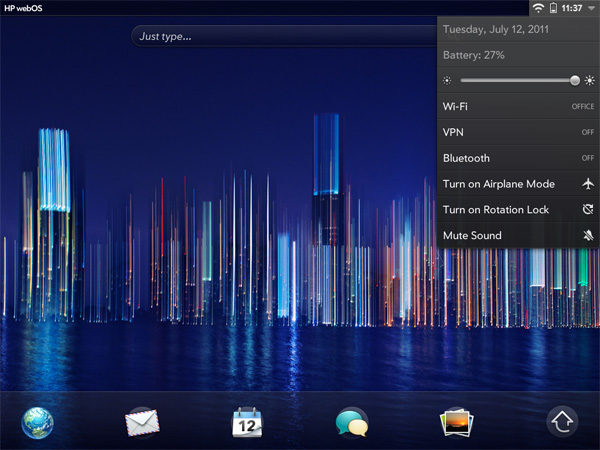
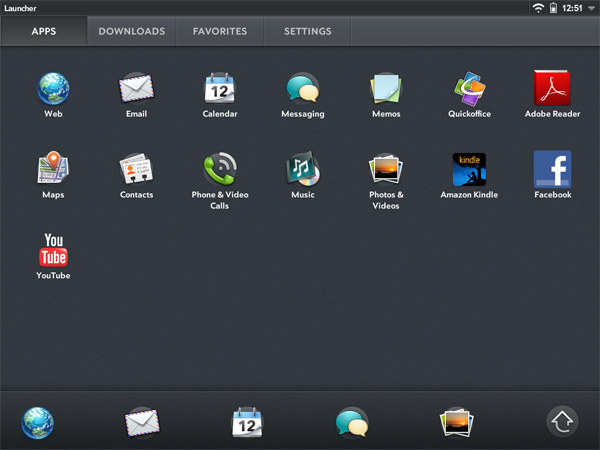
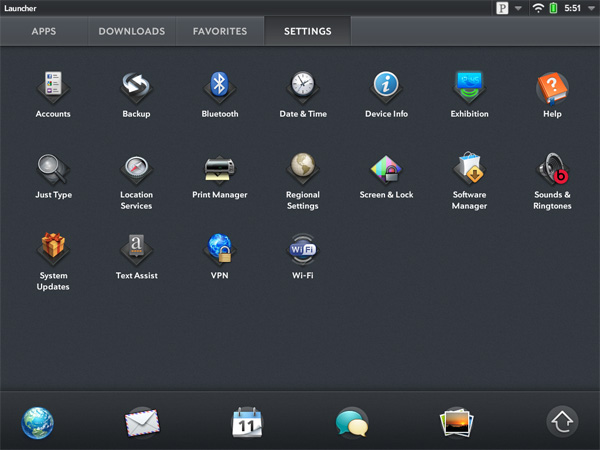
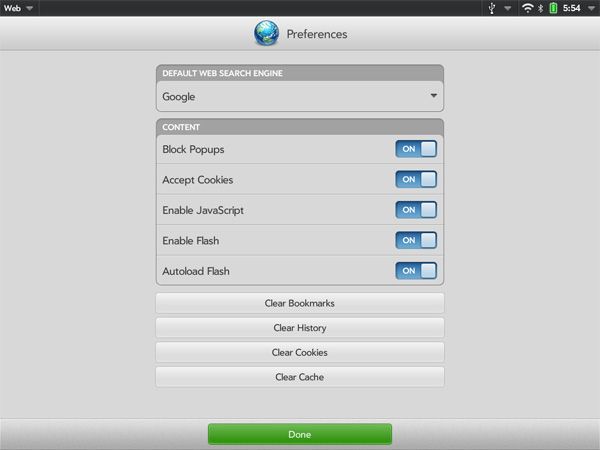
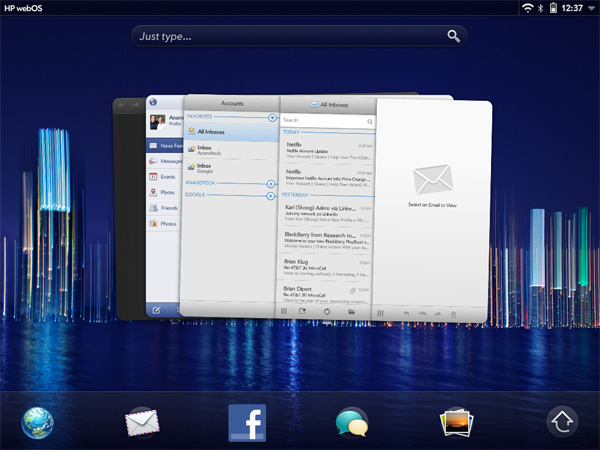








67 Comments
View All Comments
bigboxes - Wednesday, July 20, 2011 - link
Please. How many fart apps do you need? :pAnand, I notice that you mention Wi-Fi connectivity. Can the Touchpad access network drives and/or can it map a network drive? Part of the appeal of a tablet is not just to access the internet, but to access the intranet as well. It is disappointing that there is limitations placed on video formats and file size. Will there be 3rd-party apps (web browser, media player,etc.) that allow better functionality or is this a hardware/OS limitation?
One thing that is missing from this review is HP's support of the homebrew community. I would assume that there will be many programmers out there who will provide free apps and patches that will augment the touchpad. This will allow you to fix a lot of the devices shortcomings. Come to think about it that is one of the most important aspects of this platform: the ability to do what you want with your device. Whereas Apple locks down their device to ensure uniform performance, HP allows us techies the option to tinker wtih our hardware as we see fit. Thanks for the review Anand!
tecknurd - Tuesday, July 19, 2011 - link
I disagree and you talk like an Apple fan. To my own eyes iPads are restrictive. I can not go to any site with out getting an F grade. iPad are not productive when they can not handle Flash. Unfortunately the Internet still uses Flash.The problem with any OS is applications. Until developers adventure to other OS, applications will be limited. Linux has the same problems and still have the problems with having good applications. In Linux there are applications for office tasks such as OpenOffice, but I would not use it for a business because it is very limited.
Of course it is not the OS. It is the applications for tablets or for any computer. If I am force to buy an iPad like you say, I would just get a Mac book Air or similar.
I against the iPad and iPhone because I think there is something better from other brands. Actually this is true and Apple wants those brands kicked out. I do not support such a thing.
codedivine - Sunday, July 17, 2011 - link
The WebOS internals folks have stepped up and released a patch that reduces the amount of logging the OS does. Apparently it seriously improves performance. If the OS is indeed doing a whole bunch of disk IO that it shouldn't be doing, that will explain a lot of the lag issues.AmdInside - Sunday, July 17, 2011 - link
"The application launch time is livable however, it's something you can get used to and hope that HP will improve over time. There are two bigger issues with the TouchPad's performance that are harder to deal with."I beg to differ. This is the major reason why I sold my iPad 1 to get the ipad 2. When I tested an iPad2 after a friend bought one, I couldn't believe how much faster it launched apps. I could never get used to the launch time of the iPad 1. I am really happy with the iPad2's application launch times. I could not imagine going back to an iPad 1.
cioxx - Sunday, July 17, 2011 - link
HP isn't about building and nurturing consumer ecosystems and neither was Palm with its latest incarnation after WebOS introduction. HP's DNA is basically moving large amounts of units to corporate/conservative customers and getting on to the next model.The fact that they announced a faster Touchpad after 2 weeks of having released the first one is testament to that schizophrenic behavior.
There is absolutely no guarantees that WebOS will get better or that HP leadership will get their heads out of their ass and behave like a consumer-friendly company.
Just look at their idiotic ads to get an idea what decision-makers at the company consider to be hip or relevant.
The "It's not an iPad" crowd is pretty tiny and I've yet to see a credible tablet on the market which answers the fundamental question - "Why get this instead of an iPad?"
halihassan - Monday, July 18, 2011 - link
in the mail section you mention that there is no way to mark multiple emails for deletion. This is not true; when multiselect is enabled, the email app allows you to delete, flag, and move multiple emails.Anand Lal Shimpi - Monday, July 18, 2011 - link
Wow you're right, I definitely missed that! Fixed!Take care,
Anand
arbarath - Monday, July 18, 2011 - link
Nice Review..I personally use Eee Pad transformer, It personally satisfies all my needs. I went n bought a tablet that it should reduce the usage of my Laptop or PC atleast by 40 to 50% and its doing it although it cannot replace entirely.
There are lot of space for performance improvement on honeycomb, but i like it thus far. Regional Fonts are missing in honeycomb, like mine (Tamil) its the biggest thing i miss so far .. I stream movies from my Home Server using smb including all formats, transfer files like you do on desktop or laptop.its great.
HP tablet looks nice and it will be an intersection of iOS and Android. Card feature is really interesting and nice.
Great review. keep it up. thanks.
Omid.M - Monday, July 18, 2011 - link
Awesome review, Anand.Looks like the tablet to beat if HP can issue some updates to address the bugs you pointed out. Have you sent a list of these bugs (scenarios in which they were encountered, so they can be reproduced) to the product manager for the Touch Pad or a media relations person at HP? If not, you really should.
Google +, Google & Amazon music integration, Netflix, and better battery life (and no hiccups) would make this the ultimate tablet. I'd pick one up asap if those were addressed; I'm not sure how swiftly HP would do that, though.
Some errors I spotted in the review:
Format:
Line with [error]
[correction]
(Page title the error was spotted on)
It does get worse on the [PlayBook] unfortunately.
[TouchPad, ]
(HP app catalog)
[Seek] shelter or [be] a hermit with your new tablet are the only present day solutions.
[Seeking]
[being]
(Display)
[IT's] still a [dual-issue] in-order architecture
[It's]
[dual-issue,] --- add comma
(Performance)
With a few benign apps [open] the TouchPad multitasking experience is fine.
[open, ] --- add comma
(Performance)
@moids
Impulses - Monday, July 18, 2011 - link
Excellent review, it's a shame webOS isn't gaining traction any faster and HP isn't pushing devices out the door any faster... WP7's UI design is interesting, but webOS has features that still make many honest Android and iOS users jealous.I would've loved to see where that IM conversation about GPUs was going. ;) BTW, I don't know about iOS, but there's like half a dozen Android solutions for synchronizing or connecting your phone to a PC in order to be able to SMS from the PC, and even view the phone's notifications. I don't think there's any Honeycomb solution yet tho, short of Google Voice, which not everyone can use or integrate.